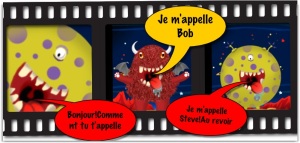After trialling the new iPads during our French Summer School I have found a number of excellent apps for use in the MFL classroom. Many of these can also be used on an iPodTouch (marked with an *), which makes it more affordable for a school to use. I’m not going to mention specific language apps here (apart from the dictionary) as I was more interested in the apps for creating work in the MFL classroom. Isabelle Jones has written some excellent blog posts on language specific ones here.
 * I use the Collins French Dictionary (also available in German and Spanish) which at £5.99 is the most expensive app. This has just enough detail, i.e. some idiomatic phrases, whilst still being simple enough for younger students to use. I like the Fuzzy option, that means you don’t need to spell the word correctly for it to find it.
* I use the Collins French Dictionary (also available in German and Spanish) which at £5.99 is the most expensive app. This has just enough detail, i.e. some idiomatic phrases, whilst still being simple enough for younger students to use. I like the Fuzzy option, that means you don’t need to spell the word correctly for it to find it.
(The £14.99 Pro versions are excellent for A-level students and beyond).
 * Doodle Buddy is a free drawing app and can be used to make the iPad into an expensive mini-whiteboard. Great for individuals or groups to show their answers, and for pairwork. For example one students draws a person, then describes them to their partner (e.g. He has blue eyes and green hair). The partner draws what they hear, and then they compare the result. It also has a noughts and crosses grid, ideal for bingo!
* Doodle Buddy is a free drawing app and can be used to make the iPad into an expensive mini-whiteboard. Great for individuals or groups to show their answers, and for pairwork. For example one students draws a person, then describes them to their partner (e.g. He has blue eyes and green hair). The partner draws what they hear, and then they compare the result. It also has a noughts and crosses grid, ideal for bingo!
 * Fotopedia Heritage is free and contains 20,000 high-quality photos of all the UNESCO World Heritage sites. You can search via the World map and star favourites. You can use it to look at images of countries where the language is spoken and talk about the culture and landscape. See also the Fotopedia Colors app, which has beautiful images of people from around the world.
* Fotopedia Heritage is free and contains 20,000 high-quality photos of all the UNESCO World Heritage sites. You can search via the World map and star favourites. You can use it to look at images of countries where the language is spoken and talk about the culture and landscape. See also the Fotopedia Colors app, which has beautiful images of people from around the world.
 Moodboard Lite (free) is aimed at artists, photographers and designers to help them organise their ideas, but is ideal for creating posters too. You can connect to the internet through the app, then find and crop images to add to the Moodboard. Text can be added and edited, to label images. I used this for a poster on colours as you can add ready-made colour palettes. The free version can only include 7 images, but we found it enough for our purposes.
Moodboard Lite (free) is aimed at artists, photographers and designers to help them organise their ideas, but is ideal for creating posters too. You can connect to the internet through the app, then find and crop images to add to the Moodboard. Text can be added and edited, to label images. I used this for a poster on colours as you can add ready-made colour palettes. The free version can only include 7 images, but we found it enough for our purposes.
 iCardSort (free) is a brainstorming tool, where you can add text to any number of cards which can then be moved around the screen. This can be used for sorting vocabulary (e.g. masculine, feminine, neuter nouns), or creating sentences. Unfortunately you can’t change colours, background or fonts, but I like the simplicity of the app.
iCardSort (free) is a brainstorming tool, where you can add text to any number of cards which can then be moved around the screen. This can be used for sorting vocabulary (e.g. masculine, feminine, neuter nouns), or creating sentences. Unfortunately you can’t change colours, background or fonts, but I like the simplicity of the app.

Infinote Pinboard for Todos and Notes Free can be used in a similar way. This is for brainstorming and creating To Do notes, and there are more options to change the colour of notes, text and add icons. This could be used for revision purposes, or colour coding types of words (make all adjectives green, nouns blue etc).
 * Make a Martian (free) simply allows you to create a Martian, using a number of different body shapes, colours, arms, wings, eyes, legs etc. Once you have created a Martian you can take a screen shot of it (press Home and Power button together), and use it in another app, for example Moodboard or Strip Design. Great for work on colours and parts of the body, and a simple way to create characters for conversation work.
* Make a Martian (free) simply allows you to create a Martian, using a number of different body shapes, colours, arms, wings, eyes, legs etc. Once you have created a Martian you can take a screen shot of it (press Home and Power button together), and use it in another app, for example Moodboard or Strip Design. Great for work on colours and parts of the body, and a simple way to create characters for conversation work.
 * Strip Designer (£1.79) is well worth the money. It is really simple to use and students can create nice-looking comic strips using images from the iPad’s My Photos. Perfect for conversation work, displays etc.
* Strip Designer (£1.79) is well worth the money. It is really simple to use and students can create nice-looking comic strips using images from the iPad’s My Photos. Perfect for conversation work, displays etc.
 * Idea Sketch (free) is a mind-mapping app. There are a number of these available, but I liked this one as it is simple and uncluttered. You can change the colour and shape of the text boxes, add notes and view it as a list. Great for vocabulary revision.
* Idea Sketch (free) is a mind-mapping app. There are a number of these available, but I liked this one as it is simple and uncluttered. You can change the colour and shape of the text boxes, add notes and view it as a list. Great for vocabulary revision.
 i-Prompt Pro (free) turns the iPad into a teleprompter. Use when students are recording audio or video from a script. Type in the script and set how slow you want the text to move. It’s a little fiddly to set up, but works really well.
i-Prompt Pro (free) turns the iPad into a teleprompter. Use when students are recording audio or video from a script. Type in the script and set how slow you want the text to move. It’s a little fiddly to set up, but works really well.
 Voice Recorder for iPad (£0.59) allows you to create high quality recordings using the inbuilt microphone on the iPad. I chose this one simply because I had read a good review of it, and it seems easy to use. Unfortunately I’ve not found a way to use the audio in other apps, or download it off the iPad, but still a useful app to record practice conversations.
Voice Recorder for iPad (£0.59) allows you to create high quality recordings using the inbuilt microphone on the iPad. I chose this one simply because I had read a good review of it, and it seems easy to use. Unfortunately I’ve not found a way to use the audio in other apps, or download it off the iPad, but still a useful app to record practice conversations.
Extended list:
Here are some more apps that would be useful for creating multimedia work in MFL.
*Splice (Free version has ads) – this is a video editor, but can also be used to put together slide shows with text and narration, ideal for presenting new vocabulary, or longer pieces of spoken work.
Book Creator (£2.99) – you can create ebooks and include images, videos, text and audio. Perfect for more creative use of language, and a simple way of combining all four skills of reading, speaking, listening and writing.
*Puppet Pals (free, upgrade for more characters and sets) – This is a lovely app for creating animations using the included characters and backgrounds and recording a narration as you move them. Ideal for making role plays more exciting. See also Sock Puppets and Toontastic.
This is just a small selection, and I’ll add to the list as I find more. Please add any suggestions for other apps in the comments.






 Posted by ssclc
Posted by ssclc 



